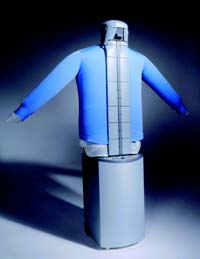

The main objective of the Dressman robot is to dry and press shirts. On placing a damp shirt on the ironing figure, this dummy inflates with hot air in its interior, and thus puffs the shirt up, removing creases drying the garment (it has to be previously wet and undergone a spin-dry in a washing machine).
The device has a heater box inside with a number of different resistance elements. While we are placing the shirt on it, this box stores up heat in such a way that, when the garment is positioned and we press the start button, the whole ironing dummy fills with hot air which presses and dries the shirt. Moreover, the device has an air filter which prevents dirt entering the ironing dummy.
The time for the ironing process is selected by the user. The temperature of the resistance elements is not, only the cycle time, which lasts from 4 to 15 minutes, depending on the type of cloth in the shirt being ironed (a normal cotton shirt usually takes 7-8 minutes). These times are selected on a rotary selector that is on the device itself.
When the ironing process has finished the device blows cold air for 1 minute in order to stabilise the cloth and thus prolong the effect of the ironing.
The size of the dummy adjusts perfectly to that of the garment, allowing the pressing of all kinds of shirts, including short-sleeved ones. Moreover, we can use the apparatus for all kinds of cloth, except for elastic ones, as the air pressure will make the garment.
Apart from the ironing cycles with the rotary selector, we can select a cycle where only cold air is blown simply in order to ventilate shirts and jackets.
The ironing dummy is made up of three different types of cloth, each with a distinct permeability and, thus, allowing more or less hot air to the exterior. The reason for this is that more hot air flow is needed in some areas of the shirt than in others because the cloth thickness is greater or there is a double layer of cloth (for example in the pocket zone or at the cuffs. What is more, ironing dummy can be washed in the washing machine.
One of the advantages of this device is that, while the frame of the iron can get to very high temperatures, the temperature of the dummy never gets to damage the garment. Moreover, the base of a conventional iron crushes the cloth, in such a way that it loses its pristine look after a few ironings. However, with this ironing robot system, the cloth is maintained undamaged for longer periods and the shiny patches that appear on certain materials with conventional irons.
Some numerical data:
- The device measures 173 x 36.5 x 45 cm when in the upright position and, when folded, the height is 119 cm.
- Its weight is 28 kg. It has wheels and a handle by which it can be easily moved from place to place.
- It consumes about 3300 W or 2150 W. The user has the choice, by pressing a button combination, of having the machine work with 2150 W and, thus, consume less energy.














